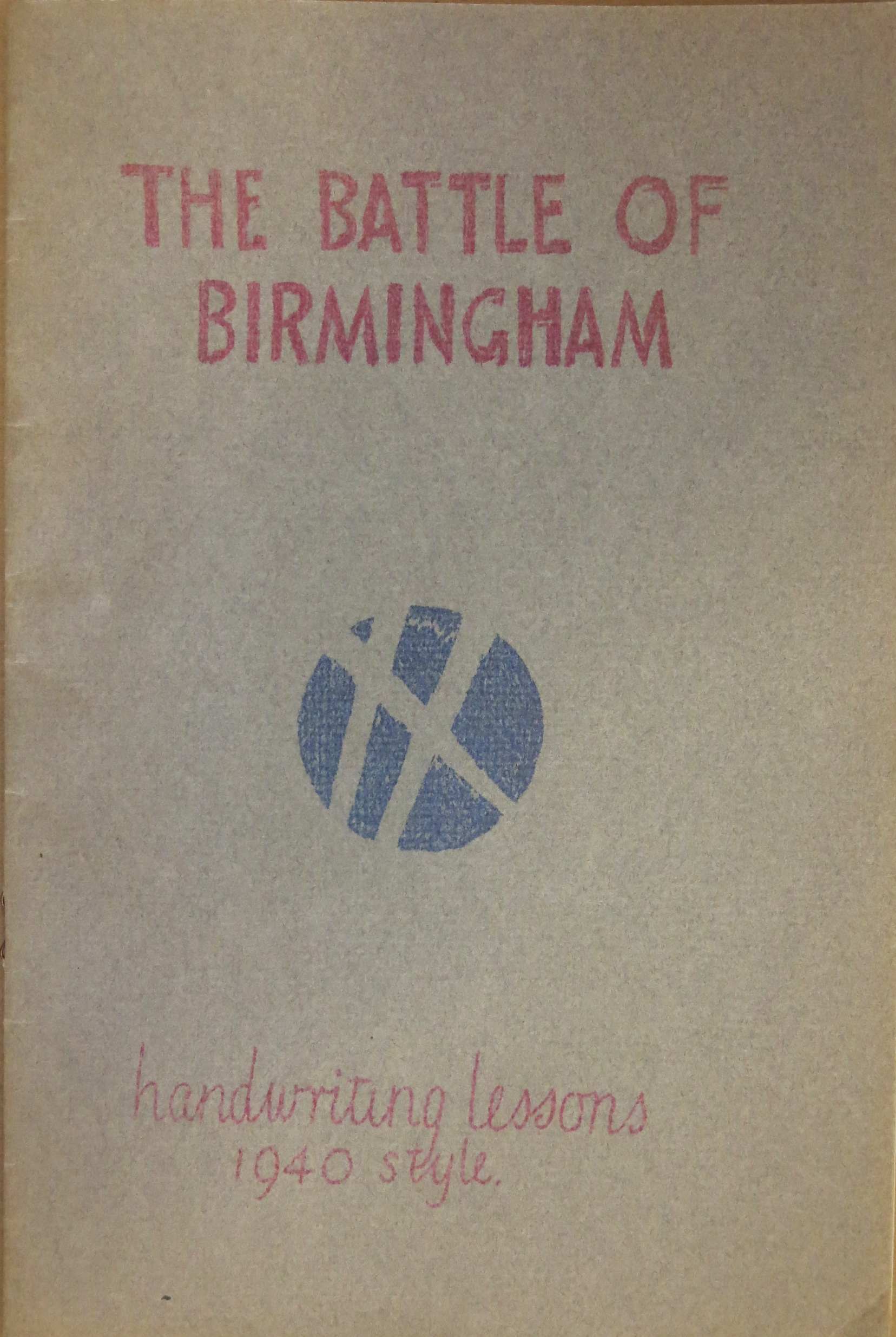J. L. Carr.
The Battle of Birmingham
This is a small book of verses that Carr made and and wrote on the blackboard at a school in 1940 for his pupils to copy and practice their hand writing. He reproduced the verses with comments and autobiographical notes in 1966 using a mimeographic process. The Foreword below explains why and how.
P-JLC1: First and only edition
Cover title: The Battle of Birmingham. Handwriting lessons 1940 style
Author: none stated
Publisher: none stated
Year: September, 1966
ISBN: None
Size: 218 x 144 mm
Pages: 32
Staples: two
Binding: grey thick printed paper covers
Printing method: mimeography
Paper: white
Cover artist: [J.L. Carr]
Internal illustrations: none
Number in series: none given
Colophon: none
Telephone number: none
Printing history: none stated
Number of other titles listed: none
Printed by: not stated
Copy: Kettering Public Library, ex Edmund Cooney
Front cover (click to enlarge)
Pagination: Front cover; An Explanation of Sorts; blank page; Continued Explanation; blank page; Poem 1 and notes; Poem 2 and notes; Poem 3 and notes; Poem 4; Poem 5 and notes; Poem 6 and notes; Poem 7 and notes; Poem 8 and notes; Poem 9 and notes; Poem 10 and notes; Poem 11 and notes; Poem 12 and notes; Poem 13; Poem 14 and notes; Poem 15 and notes; Poem 16 and notes; Poem 17 and notes; Poem 18 and notes; Poem 19 and notes; Poem 20 and notes; Poem 21 and notes; Poem 22 and notes; blank page; Poem 23 and notes; blank page; blank page; blank page; rear cover.
Notes: Except for the 'Explanation', which is typed, the verses and comments are written by hand. The verses are not titled. Underneath most verses is a short explanatory note or an autobiographical recollection.
AN EXPLANATION OF SORTS
Before going any further, I concede the banality and incompetence of these verses. Their only possible interest is for a few Birmingham people who were in the same vacuum at the time. Their only faint justification for being duplicated into a few copies is that I suppose that they might be considered as a minor social document of a particular time and place.
I was clearing out an attic the other day and came across a boy’s exercise book in which were copied these verses. This is how they came to be there.
In 1939, I returned westwards across Asia from a year teaching in the USA and went back to my old lodgings in Handsworth Wood Road, believing then that I should soon be called-up, I took a temporary post at Hastings Road Senior School, Kingstanding. Except for the removal of the glass panes from windows set in the room doors and a few desultory air-raid drills, the school carried on its previous routine. In April, 1940, I went to relieve an evacuated school in Chepstow and then the war really began. In Cardiff station I saw half-clothed and weaponless survivors of Dunkirk, half-stunned in a train chalk marked ‘DID WE SEE THE RAF? DID WE HELL!’. Soon after that air attacks on Bristol began but, by September, threat of invasion was over and scattered night attacks on midland cities began.
When I returned to Hastings Road the youngest teachers already had gone and, knowing that I’d only a few weeks left, the headmaster gave me a form of boys of low academic ability. For some reason they had about three handwriting periods each week and I soon found that the poetry he had asked me to give the form to copy meant very little to even those who understood its vocabulary. So I got into the habit of ‘roughing’ out a few lines in the staff-room on scraps of paper and then making some sort of pattern as I wrote them on the blackboard. (It had the same dangerous excitement as an amateur tightrope walk because there was no retreat since the form wrote it down as fast as I chalked it up!)
As far as I was able I made the verses suit the times and the situation and salved my conscience by reflecting that they had ‘Literature’ at other times of the week as an antidote. The important thing was to get the right slope, height and depth. . .
When I left in October I unscrupulously must have impounded the exercise book of the best writer.
And thus back to the attic twenty-six years later ...
27 Mill Dale Road, Kettering, September 1966
Although Carr's Battle of Birmingham had a design by Carr of searchlights on the cover, representing the bombing of the city by the Germans (Carr was acting as an air-raid warden before he was called up), there had also been a Battle of Birmingham in 1643, during the English civil war.
